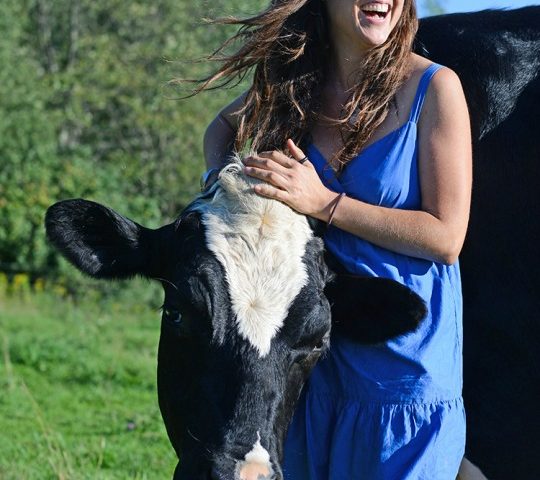Photography for photojournalist Jo-Anne McArthur is not about securing a “pretty” shot – it’s about documenting conditions as they are, and inviting her audience to challenge the scenarios that have been
normalized. She seeks to share what she, herself sees, while allowing the viewer make his or her own discovery.
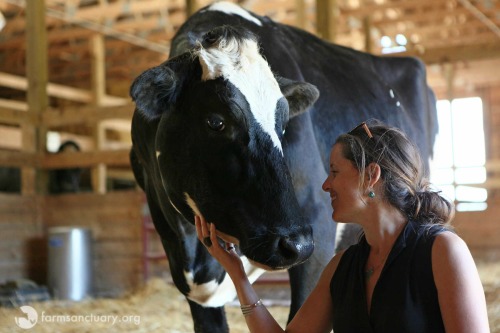
Reflecting on just how their journeys intersected: Fanny and Jo-Anne
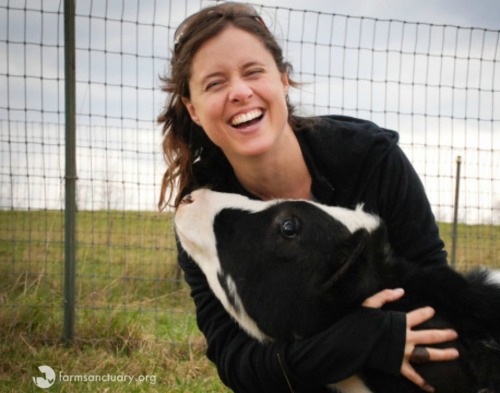
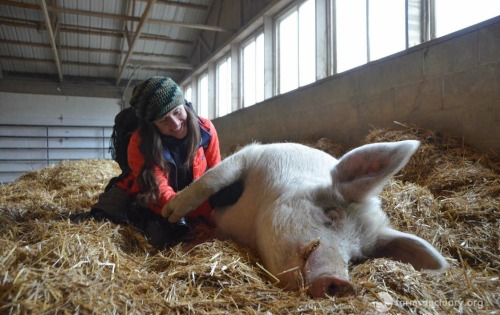
Jo-Anne gives Andy a belly rub
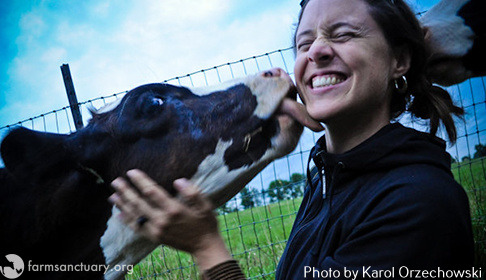

One of Jo-Anne’s biggest a-ha moments fittingly occurred from behind the
lens. It was the second day of her Farm Sanctuary internship, her shift was
over, and she was wandering our New York Shelter grounds with her camera. “I
was photographing my feet next to [a steer named] Arbuckle’s feet,” she recalls. “But I was
wearing leather hiking boots – at the time that’s all I owned, so that’s what I was wearing. It was such a visceral reaction – from happily taking pictures and then having that connection happen.
Recognizing that what’s on my feet is the actual animal next to me: this beautiful, beautiful being. I wish everyone could have that experience. We all think, ‘Oh, leather’s just a byproduct, it doesn’t really matter.’ But I gained a greater understanding that day by having that experience.”
And in that instant, she clearly saw how her choices made a direct impact on those around her and realized just how connected we animals – human and non-human alike – truly are. “That’s why sanctuaries are so important,” says Jo-Anne. “People have the opportunity to meet the individuals we eat, and who we wear by extension. And you cannot possibly see an animal as some ‘thing’ in a situation like that. It becomes clear that they’re a someone, not a something.”
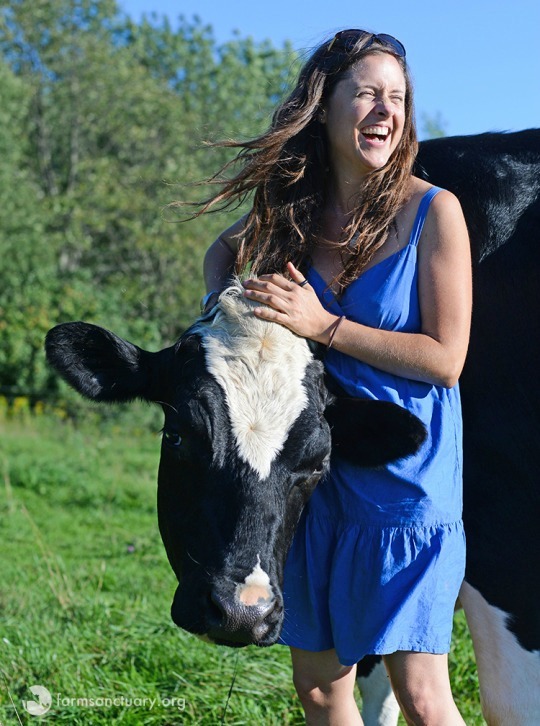
Jo-Anne with her pal Sonny.
To this day, Farm Sanctuary offers Jo-Anne a haven between trips worldwide, bearing witness to the harsh realities of harsh realities of animal abuse and exploitation.
“Farm Sanctuary is a life-changing place,” says Jo-Anne. “And it altered the course of my life and career. It was a place that solidified my beliefs and deepened my understanding of animal rights. It confirmed my commitment to them. And these sanctuaries are not only places for animals, but for humans as well. Sanctuaries are places that validate how we feel about compassion and changing the world. They are places to commune with like-minded people and present the kind of education that you cannot get in a classroom.”
Farm Sanctuary recently featured Jo-Anne with a “Hero of Compassion” award for selflessly devoting her life to motivating others to stand up and act on behalf of the animals we serve. “[Compassion] means looking beyond our own needs and desires, and considering how our actions affect others,”
Jo-Anne explains. “It means always trying our best to live in a way that doesn’t cause harm to people, animals, and the environment.” People respond to injustice in different ways – and though her approach differs depending on the project she takes on, Jo-Anne effectively turns the lens inward, helping us
understand how intertwined the human and non-human worlds really are.
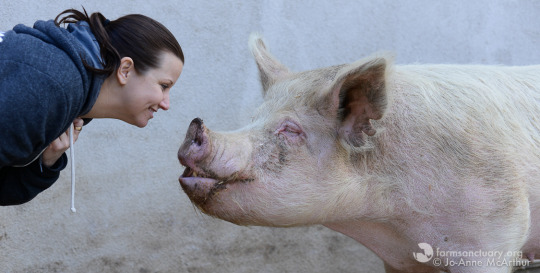
Kelly O’Neil goes nose-to-nose with Sophie pig.
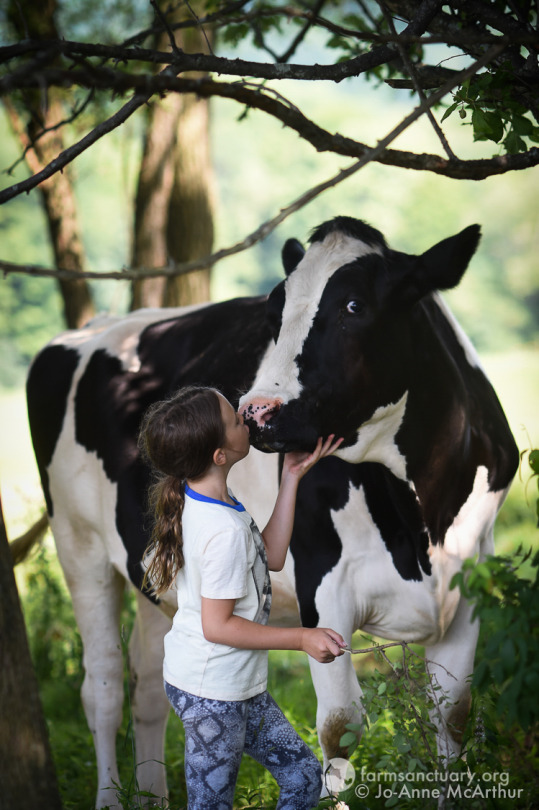
Maggie Stewart places a kiss on Ted steer’s nose.
Jo-Anne’s most acclaimed endeavor is We Animals, an extensive archive depicting
humans’ relationships with animals in various settings. “We Animals aims to break down the barriers that humans have built which allow us to treat non-human animals as objects and not as beings with
moral significance,” Jo-Anne explains on her website. “The objective is to photograph our interactions with animals in such a way that the viewer finds new significance in these ordinary, often unnoticed situations of use, abuse, and sharing of spaces.”
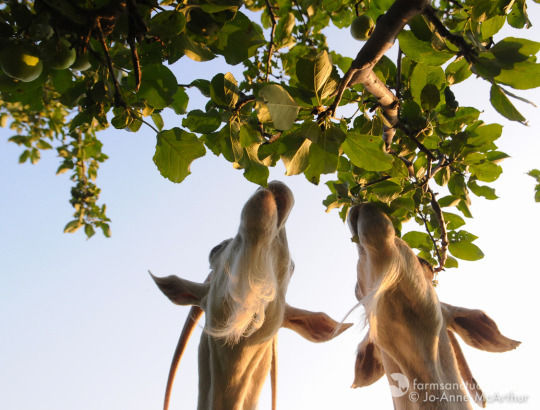
Shante and DiMaggio at the apple tree.
While Jo-Anne’s work brings her around the world, it’s
important to note that animals are subjected to terrible abuse every day –
even, and especially, in our own backyard. It’s easy to categorize these
horrific actions as belonging to places away from ourselves, and outside of our
own involvement. Contrast that with animal agriculture, an industry largely successful because corporations keep the animals we raise for food largely hidden from public view; the
animals’ experiences are sanitized with industry labels like “organic” and
“cage-free,” descriptions that tap into the hearts of well-meaning individuals
who are interested in making more compassionate choices.

Ben’s friend Katherine was born at a “humane” facility that advertised grass-fed lambs. Sadly, her mother was one of dozens of sheep found in wretched conditions, emaciated, and afraid. This is why it’s so important for people who want to make more compassionate choices to research the industries they support.
What makes Jo-Anne so influential, however, is her emphasis
on seeing – on entreating her viewers to give the animals that society tends to
overlook the attention and acknowledgement that all beings deserve. “I hope
you’ll take the time not just to look but to see – if only as a mark of respect for the billions of animals
whose lives and deaths we don’t notice,” Jo-Anne explains in her book, also titled We Animals. “To look…is to bear witness with me, which means also
that we confront cruelty and our complicity in it. As a species, we have to
learn new behaviors and attitudes and unlearn the old ones.”

One way of doing so is by inspiring individuals to connect
with the individual animals themselves – to enter into their world, empathize
with their plight, and commit to making a difference. While some of Jo-Anne’s
photos cover animal abuse on a grand scale – depicting thousands of turkeys
crammed into one barn, for example – she also finds it important to engage with
an animal on his or her own level, to help her viewers understand the severity
of the issues at hand.

All acts of compassion, no matter how small, make a huge difference in an animal’s life. A Farm Sanctuary guest befriends Grace sheep.
While Jo-Anne’s images prompt us to address our own
involvement in systems that promote cruelty and suffering, she is also
sensitive to the fact that acknowledging our contributions can be so paralyzing
that we do nothing to change it. Jo-Anne recognizes that most people inherently
want to do good, but evidence suggesting they are doing otherwise can be
disconcerting. So she meets people where they are, gently encouraging them to
at least bear witness to the suffering that exists.
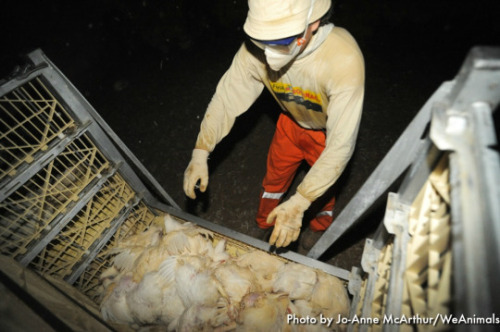
Chickens being loaded into crates for transport.
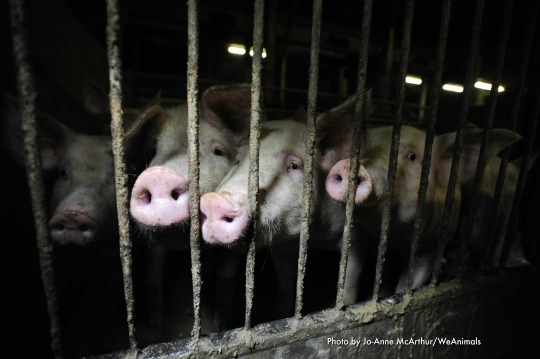
Pigs at Finland factory farm
Jo-Anne’s photojournalism takes a different direction than
the animal photographs that society is used to seeing. Jo-Anne remarks that
there are markets for exotic and domesticated animals – groups that we tend to
revere from afar or with which we are more familiar. “The images must provide the viewer with the opportunity to gain insight,” she explains in We Animals.
“They should draw the viewer in and let her linger on what she sees, to feel
disturbed or intrigued in a way that would compel her gaze ultimately to turn
inward, where questions and changes begin. It’s my firm hope that once that
happens the viewer will make the decision not to support the industry that
brought about that animal’s misery. I also want viewers to share the
photographs with others. In this way, an individual experience becomes the
catalyst for a dialogue about the rights of animals and our responsibilities
towards them.” And Jo-Anne graciously makes her work available for anyone to
use through the We Animals archive, so we can work collectively to enact
positive change for animals and the humanimals who love them.
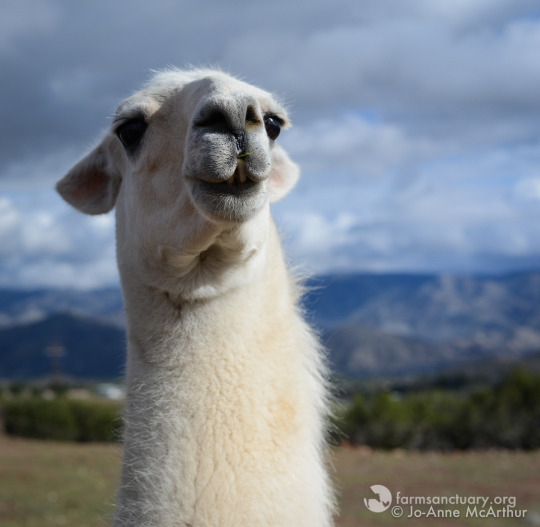
Yoda llama says, “May the force be with you.”
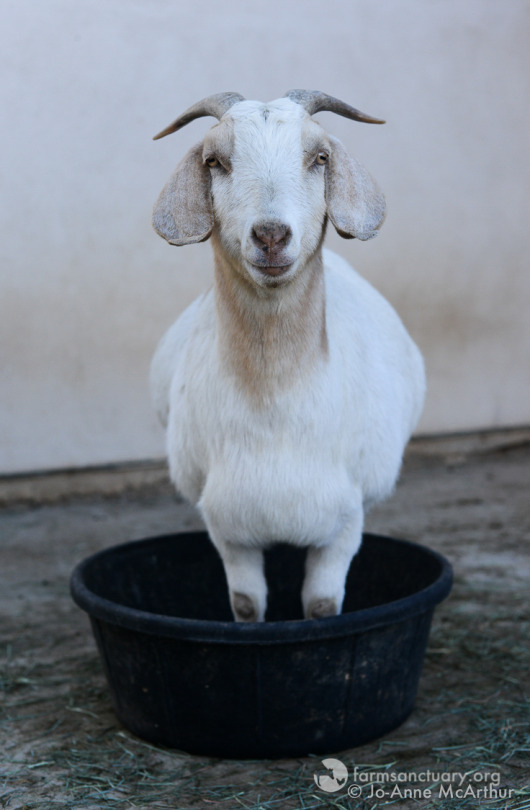
Nilla goat delivers a smile.

Reuben sheep in the pose that won placement on Farm Sanctuary’s 2016 calendar cover.
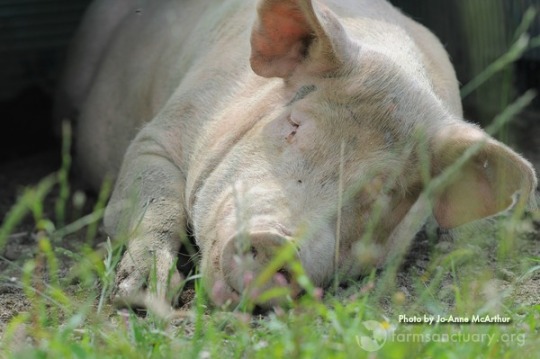
Rose in slumber.

Antoinette turkey stands tall.
Despite the heartbreaking evidence Jo-Anne frequently
shares, she also works hard to empower people by featuring inspiring tales of
triumph over adversity – such as through her photos of our rescued residents
and the individuals who care for them. “I often try to give viewers hope and
happiness. I show images that depict happiness, change, and the change-makers
themselves. This is because we see ourselves in others – images of other
advocates inspire us to be a part of the change. If we show people taking part, taking action, many of us will think I can do that too, I can see myself doing that.”

Blue comes in like a wrecking ball.
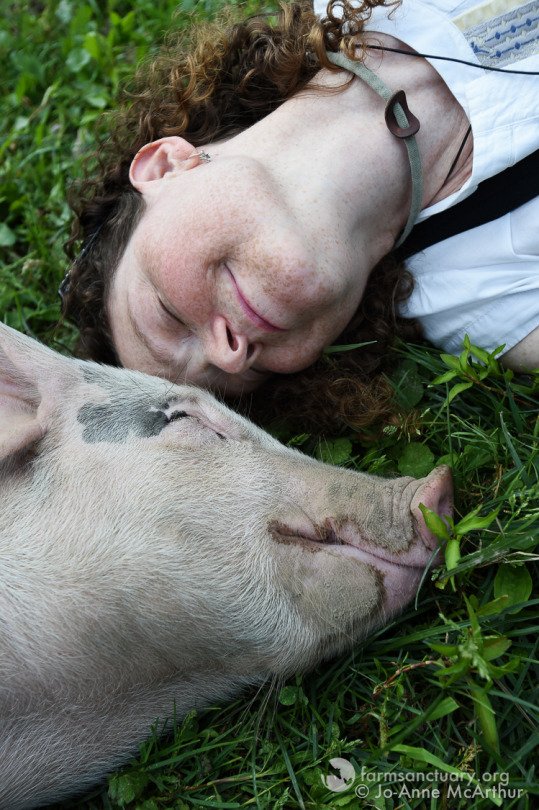
Maybelle pig snuggles up with a friend during last year’s Hoe Down.
Jo-Anne emphasizes this in a number of ways, including and apart from the We Animals project. For example, Jo-Anne is the featured human subject in the animal rights documentary, The Ghosts in Our Machine. While Ghosts depicts the horrors she routinely faces in her line of work, it also showcases the individuals and organizations – including National Shelter Director Susie Coston and Farm Sanctuary – who impart hope and change after tragedy.
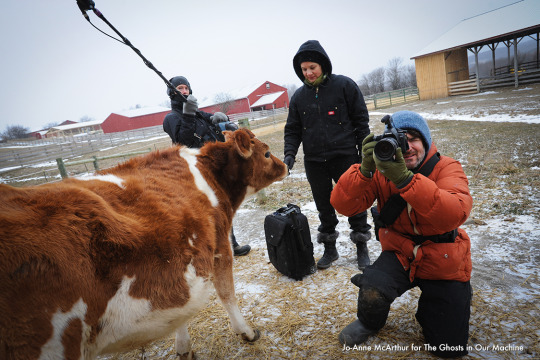
Filming for The Ghosts in Our Machine.
Susie is also featured in Jo-Anne’s latest endeavor, the Unbound Project – a collaboration with co-author Keri Cronin honoring women’s accomplishments in the animal rights movement. Combined, Jo-Anne’s work covers a spectrum, disclosing ignorance and abuse at one end and love and triumph at the other.
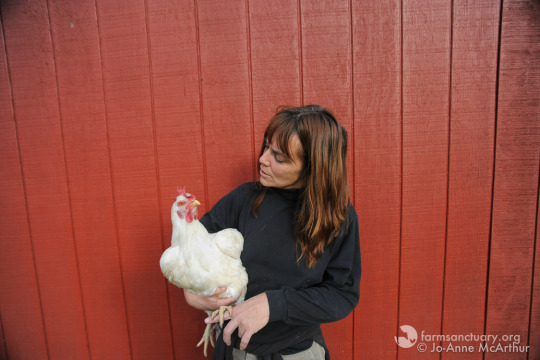
Susie with Lucille turkey.
Many of the subjects on the positive end include our own rescued residents, whose individuality and inner beauty Jo-Anne captures each time she visits the farm. She establishes unique bonds with each being she encounters, her lens serving as a medium through which others can see what she sees – that each animal has a story of his or her own, and how we may learn about ourselves by seeing the world through their eyes.
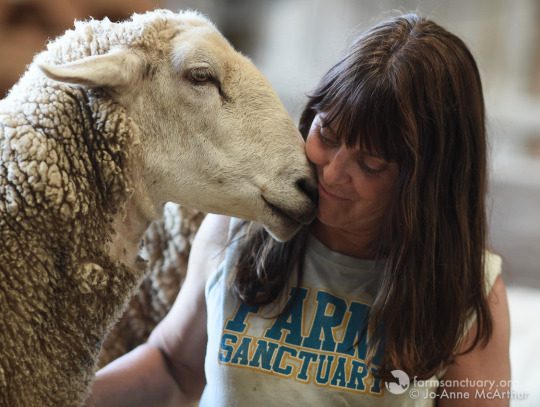
Susie gets some love from Francis sheep.
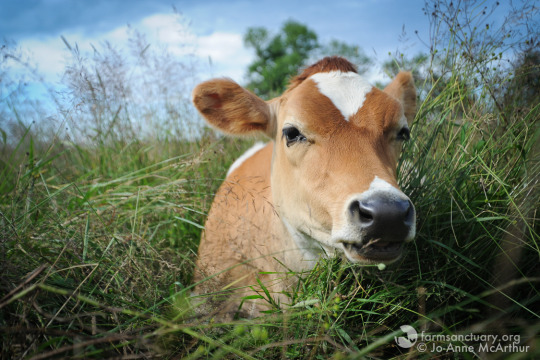
Blitzen steer enjoys a grassy hideaway.
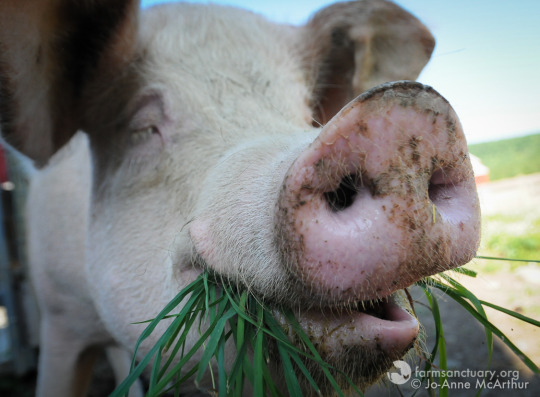
Nikki really enjoys a snack.

Ramsey studies his photographer’s lens.

Lizzie goat snags a mouthful.
The experiences that truly resonate with Jo-Anne the most are the opportunities she has to truly get to know her subjects – from the Asiatic black bears’ journeys from bear bile farms to sanctuaries, to Farm Sanctuary residents like Fanny and Sonny, whose rescues are documented in The Ghosts in Our Machine. “I always personally prefer full photo essays to single images,” Jo-Anne explains. “I like to be able to spend time with the subject and the issue. And I like doing stories of rescue where you can see a before and an after. We Animals is an analysis of human behavior, not just photos of animals themselves. The photos show our treatment of animals, and how that has to change. Creating compassion and change is the point of the We Animals project.”
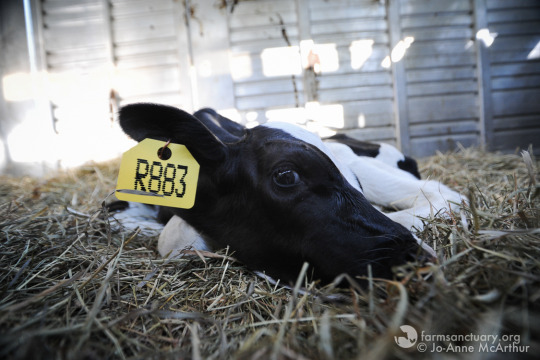
Sonny’s ear tag; a cruel reminder of the cruelties these living, feeling beings endure each day.
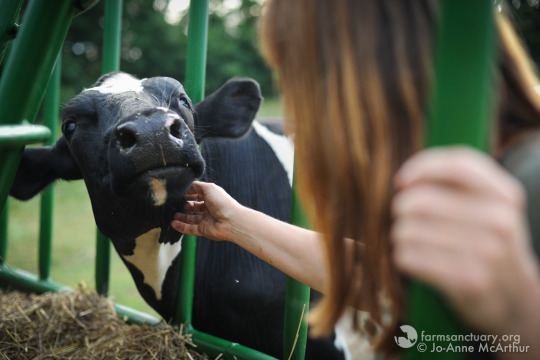
Growing up into the strong, healthy boy he is today. Here, Sonny enjoys a chin scratch from his best humanimal pal, Susie.

Beautiful Fanny, safe at sanctuary.
But getting to know animals like Julia,
whom Jo-Anne met shortly after her rescue, helps Jo-Anne realize that these
changes are indeed happening, and that more is on the horizon. “I fell madly in
love with her. She’s so special. The resilience of the Farm Sanctuary animals
amazes me. They teach us that all animals deserve our respect and help.”
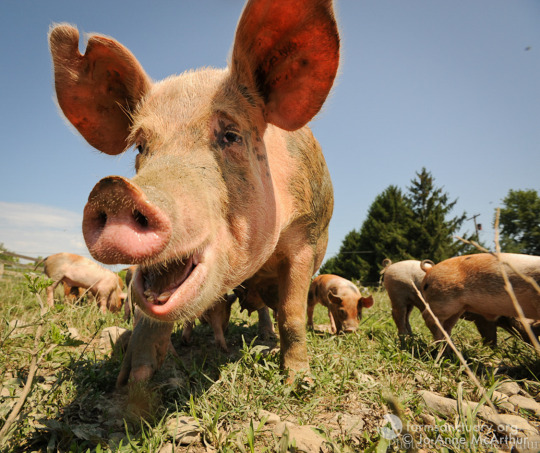

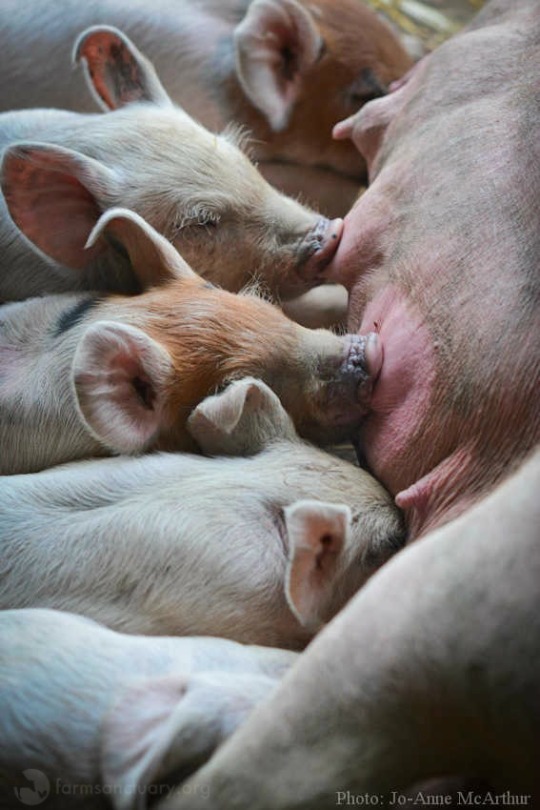
Bonding time for Julia and her babies.
Of course, it is still difficult to leave the beings we
cannot save behind. However, while the industries these animals are entrapped
in view them as invisible cogs in a machine, Jo-Anne’s work ensures that they
will always be remembered. This makes Jo-Anne’s relationships with our rescued
residents all the more valuable – it is comforting for her to bond with the
individuals who have made it, and who are continuing to change hearts and minds
through their resilience and incredible personalities.
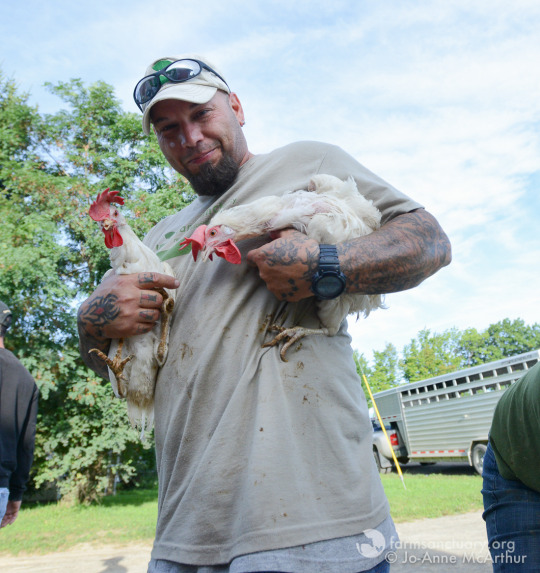
Farm Manager Mario Ramirez helps out during a large rescue involving 1,150 “spent hens.” Jo-Anne honors their new lives at sanctuary, where they will always be recognized as the unique individuals they are finally free to be.

Lila goat sneaked a peek.
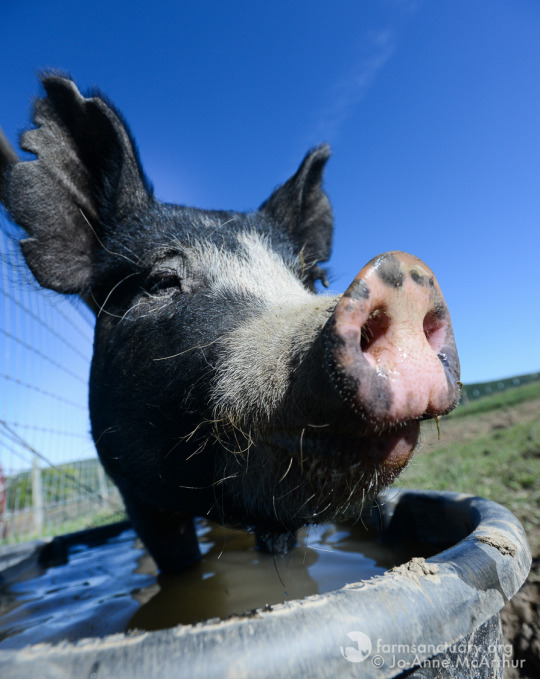
Roxy pig’s water dish doubled as a bath.
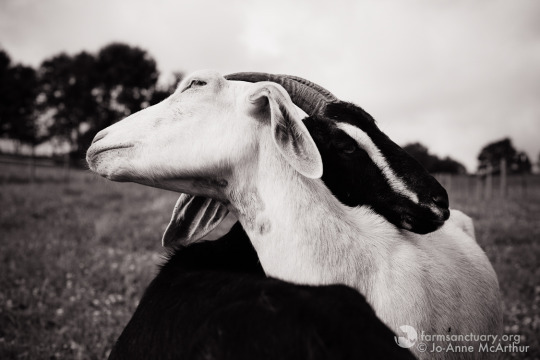
Twins Ingrid and Marilyn will spend the rest of their lives side by side, just as life should be.
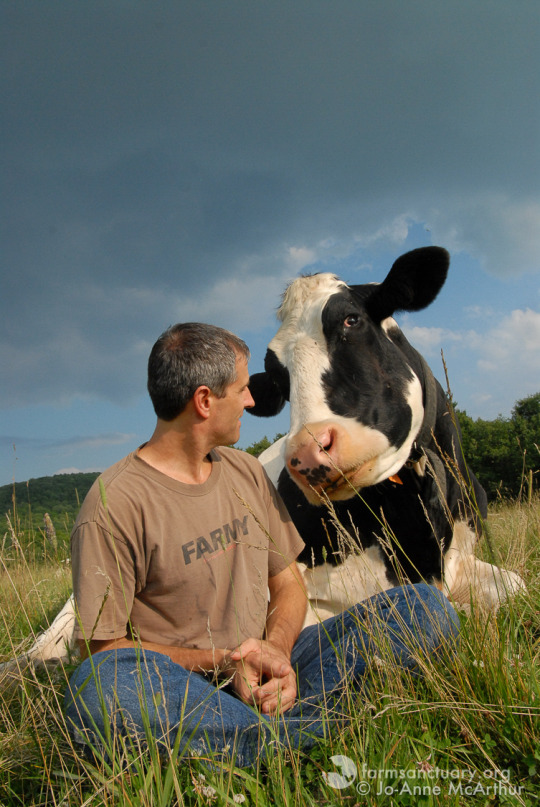
Gene Baur with his beloved pal, Opie steer.
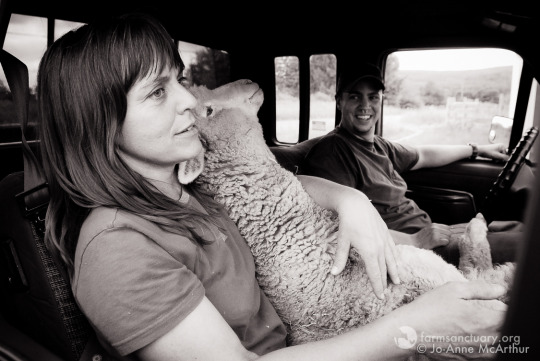
Susie escorts a Lucky Lady home to safety.

Turpentine bonds with friend Carlos during a Celebration for the Turkeys event at our New York Shelter.
“When organizations like Farm Sanctuary rescue animals and
they are then able to live in conditions which allow them to thrive and be
happy, you really get to know just how sweet cows are, and how funny chickens
are, for example, and that turkeys love affection,” Jo-Anne says. The rescued
animals become ambassadors for those locked away in terrifying confinement. We
get to know them, and then we can understand that they all deserve our help, our care, and our respect.
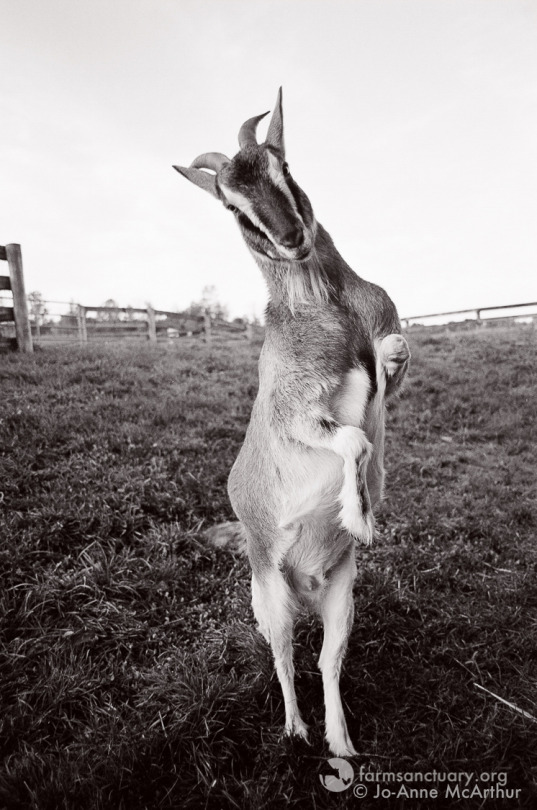
Three-legged Zoop let nothing stand in her way.
“Some of the Farm
Sanctuary residents who have been most special to me are Mayfly the rooster,
Arbuckle and Thunder steers, Zoop the three-legged goat, and Fanny and
Sonny. [They] are extra special to me because I was there to document their
rescues. Others, like Mayfly, will always be in my heart because he was just so
charming. He LOVED being with people and did that ‘attack dance’ around your
feet, but he wouldn’t attack – he just wanted cuddles. I’d pick him up all the
time and stroke his perfect, handsome plumage. He made me laugh, and so do the
chickens and turkeys. They have such big personalities, which is why I spend
hours and hours under the willow tree in the turkey enclosure when I’m
visiting.”
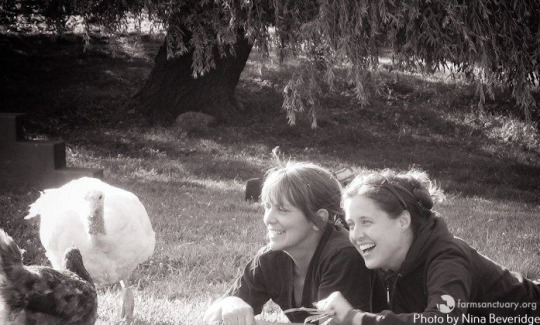
Susie and Jo-Anne enjoy a lighthearted moment while filming “The Ghosts in Our Machine.”
From her investigative work documenting the horrors that exist to her evidence of the beautiful relationships that animals and humanimals share, Jo-Anne is an inspiring proponent of change. Her advice to aspiring activists: “Think about what your skills are, and what you enjoy doing, or what you’re good at, and employ those specific skills to make the world a better place,” Jo-Anne advises. “If you haven’t figured out what that is yet, help an organization or person who is doing great work for animals. Organizations need volunteers and all manners of support. Be that person. The world needs volunteers!” Together, we can make long-lasting change for animals and humanimals everywhere – and every positive action, no matter how small, makes a difference.
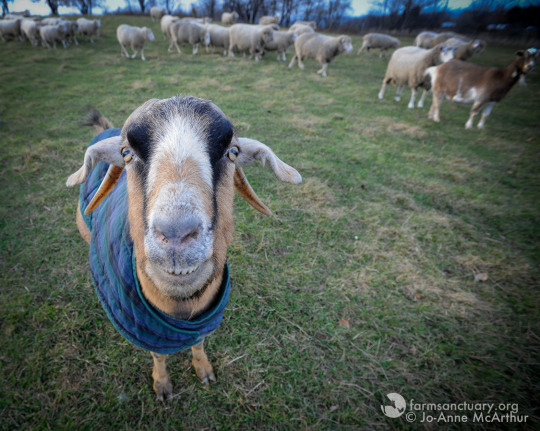
Dino was known for his winning smile.
We are incredibly grateful for Jo-Anne’s friendship over the years, as she shares how animals like our beloved friends at sanctuary are someone, not something. Jo-Anne’s support helps us reach more and more individuals about the rich, emotional lives of the animals at our sanctuaries and everywhere – and it is an honor to be a part of her incredible journey. Thank you, Jo-Anne, for including Farm Sanctuary
in your work, and for being a treasured friend to animals everywhere.
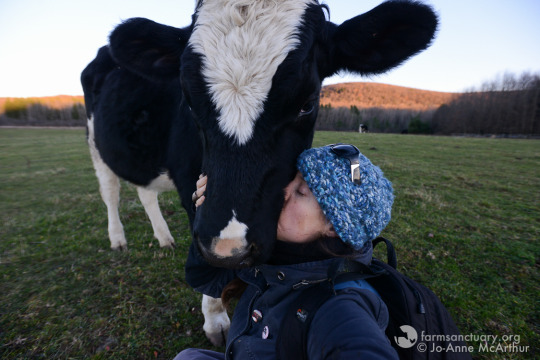
Sonny gets a smooch from his biggest fan.
To learn more about Jo-Anne, check out her recent “Heroes of Compassion” interview on Farm Sanctuary’s Compassionate Communities Campaign blog.
Jo-Anne and her work were recently featured in the music video for “A Hymn” by Revolution Harmony.
Enviroshop is maintained by dedicated NetSys Interactive Inc. owners & employees who generously contribute their time to maintenance & editing, web design, custom programming, & website hosting for Enviroshop.
